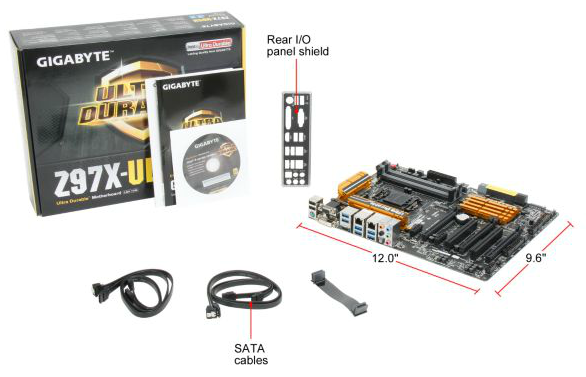GIGABYTE Z97X-UD5H Review: Choose Your Storage Option
by Ian Cutress on May 14, 2014 9:00 AM EST- Posted in
- Motherboards
- Intel
- Gigabyte
- Z97
GIGABYTE Z97X-UD5H In The Box
When we made the jump from Z77 to Z87 chipsets, behind the scenes we were informed that this switch increased the price of the chipset quite considerably. We were unable to find out exact numbers, but one would assume that as the Z87 and Z97 chipsets are relatively similar (I have seen Z97 referred to as Z87 rev.2), I would assume that high price to still be present. This means that for a competitive motherboard manufacturer trying to produce a highly functional product and in a lower price point than expected, something might have to give way. Usually that means the in-the-box contents, especially for mainstream products like the UD5H. If this was a gaming motherboard, or an overclocking motherboard, there would be scope for customization.
Nevertheless, the Z97X-UD5H contains the following:
Driver Disk
Rear IO Shield
Manual
Four SATA Cables
Flexi-SLI Bridge
With features like SATA Express and M.2 now taking center stage with the larger motherboards, I wonder if the smaller motherboards with fewer connectors will start to become more worthy recipients for in-the-box additions and out-compete the larger models. However, these additional contents are perhaps apt for the UD5H: with only one USB 3.0 header, there was never going to be a USB 3.0 bracket, and other brackets for COM/USB 2.0 headers are left for EVGA to play with. More SLI bridges are not required – this motherboard (like most Z97) supports only two NVIDIA cards, although they can support three AMD GPUs. At $190, I imagine that some of the other motherboards around this price point will carry WiFi connectivity, which GIGABYTE has redirected that investment into the dual network capabilities.
GIGABYTE Z97X-UD5H Overclocking
Experience with GIGABYTE Z97X-UD5H
Because we are using our i7-4770K sample from the first Haswell launch, unless motherboard manufacturers have found a trick I was highly doubtful that basic overclocking headroom would change. Haswell processors are characteristically warm, and the temperature becomes the limit before the voltage does on most forms of PC system cooling. The main difference might be at the high end, where extreme overclockers use liquid nitrogen for world records, but GIGABYTE has motherboards for that purpose (such as the Z97X-SOC Force).
Overclocking on the Z97X-UD5H actually mirrored the experiences with the Z87 counterparts, especially with our sample. Auto-overclocking options used a lot of voltage to ensure compatibility with more CPUs, however some strong cooling is needed for the higher options. Auto tuning was also aggressive, to the point where it failed our stability tests at 4.6 GHz. Manual overclocking gave a 4.6 GHz peak, in line with some of our Z87 motherboards, while reaching a toasty 95C during an OCCT load.
Methodology:
Our standard overclocking methodology is as follows. We select the automatic overclock options and test for stability with PovRay and OCCT to simulate high-end workloads. These stability tests aim to catch any immediate causes for memory or CPU errors.
For manual overclocks, based on the information gathered from previous testing, starts off at a nominal voltage and CPU multiplier, and the multiplier is increased until the stability tests are failed. The CPU voltage is increased gradually until the stability tests are passed, and the process repeated until the motherboard reduces the multiplier automatically (due to safety protocol) or the CPU temperature reaches a stupidly high level (100ºC+). Our test bed is not in a case, which should push overclocks higher with fresher (cooler) air.
Automatic Overclock:
Manual Overclock:













53 Comments
View All Comments
Marlowe - Wednesday, May 14, 2014 - link
Thank you. I wish there were M.2 benchmarks. Guess there are no drives out. Plextor M6e? Where are you and your friends?TelstarTOS - Thursday, May 15, 2014 - link
wrong, there are.basroil - Thursday, May 15, 2014 - link
M.2 PCIe drives worth testing don't yet exist, almost all are cheating (sata raid) or just not that great.TelstarTOS - Thursday, May 15, 2014 - link
There are two, the plextor is the lower performer, and ther Samsung XP941 that I linked above (but i'm not sure if the post was deleted - so i'm not posting a link here).TelstarTOS - Saturday, May 17, 2014 - link
Uhm it didn't take long for a review ;)XZerg - Wednesday, May 14, 2014 - link
hmmm... here i was hoping to see some storage benches but disappointment again. what's the point of calling the review "Choose Your Storage Option" when there is no storage review?kwrzesien - Wednesday, May 14, 2014 - link
Would it make sense to include the rear port cover in place for the picture? I'd like to see the finished effect, plus maybe it names which network port is Intel vs Killer.DanNeely - Wednesday, May 14, 2014 - link
Is the power consumption from the 900mhz underclocking option different from what's seen during the long idle test?DanNeely - Wednesday, May 14, 2014 - link
I really like that Gigabyte provided a block diagram of the board. Between flexible IO, PLX chips, on board USB hubs, and the sata switch used here; it can be really hard to figure out exactly what's connected where and what can be used at the same time. The diagram had almost everything I'd want to know collected in a single place; the only exception being which USB3 ports were attached to the hub.I really hope other motherboard vendors will provide similar information as well.
Ian Cutress - Wednesday, May 14, 2014 - link
GIGABYTE do this in all their motherboard manuals, so you only have to download the manual from the website and have a look. I am trying to get the other motherboard manufacturers to do this.